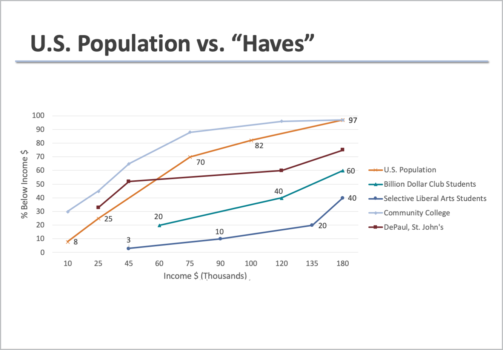 This essay is a sequel to “The Human Dimensions of Enrollment Management,” published in The New England Journal of Higher Education on June 30, 2020. In that article, my unusual focus (as a trained theoretical physicist) was on integrity, not science, as the single most important factor in enrollment management success. Early in my supervision of enrollment management (from a faculty position in the physics department at Boston College), I encountered serious challenges to that fundamental principle of integrity:
This essay is a sequel to “The Human Dimensions of Enrollment Management,” published in The New England Journal of Higher Education on June 30, 2020. In that article, my unusual focus (as a trained theoretical physicist) was on integrity, not science, as the single most important factor in enrollment management success. Early in my supervision of enrollment management (from a faculty position in the physics department at Boston College), I encountered serious challenges to that fundamental principle of integrity:
• In my first year (1972) on the job as dean of admissions at BC, my day was disrupted by a loudmouth self-proclaimed wealthy Texan in an ostentatiously large cowboy hat. He barged into my office, opened a checkbook and guaranteed me, and/or anyone I designated, “any amount necessary” to secure his son’s admission to Boston College. I evicted him summarily from our office and denied his son the right to apply.
• An influential alum (“Triple Eagle”) and BC administrator’s daughter appealed her rejection on the margin from the highly selective BC School of Nursing. The director of admissions offered the young woman a “Summer Challenge” of passing three courses (with B-‘s or better). Tragically, she received two A-‘s and a C+ and was never enrolled in the School of Nursing. That candidate was my daughter.
• In the late ’70s , the chair of the Boston College Board of Trustees insisted to the president that his daughter be provisionally admitted to BC, despite her questionable credentials. The president requested that I “make this one exception to avoid a major political risk.” I reluctantly agreed—and the chair’s daughter flunked out after one semester. Both the chair and the president agreed thereafter to make the Admissions Office the final arbiter in all cases, even at the risk of losing millions of contributed dollars for new buildings and endowment.
• For at least five years into my tenure as leader of BC Admissions, I tolerated (even countenanced) the admission of virtually all wealthy, high-scoring Phillips Andover seniors, even those in the bottom tenth of their class—while rejecting all but a handful of needy low-scoring applicants, many in the top tenth of their classes in low-income places like Chelsea, Mass. In an attempt to advance the principle of “affirmative action,” we completely reversed our strategy, rejecting many wealthy Andover applicants in favor of lower-scoring, needy Chelsea applicants, with great results: More top Andover students began applying and gritty Chelsea students succeeded well beyond what their SATs might have predicted. Careful science-based research at BC documented the weak relationship between our ideal redefinition of “quality” (courageous, never-give-up grit, achievement against odds, work ethic—not wealth, social status) and test scores.
I take obvious pride in these displays of integrity by our enrollment team, which have served Boston College—and later other Maguire Associates client institutions—very well over these past 40-plus years.
These examples stand in stark contrast to the much-publicized multiple scandals of “Varsity Blues,” in which status-seeking celebrities are too often willing to write hundreds of thousands of dollars in checks, risk prison and disgrace, and dishonor their most sacred duty to (in the words of Crosby, Stills, and Nash) “teach your children well” about integrity and honesty.
At the highest levels of American leadership, there are now documented examples of secret payments to stand-in SAT test-takers to gain undeserved university admissions and to assist with writing assignments to cover up laziness and corruption—and nonstop braggadocio about fraudulent academic achievements. And too often the names of wealthy criminals remain on buildings and academic departments!
More recently, to underscore the offenses of the entitled well-to-do people whom I confronted earlier in my career—and who continue to seek unfair advantage in Varsity Blues pursuits—expensive legal actions on behalf of disproportionately “entitled well-to-do’s” are accusing Harvard and now Yale of law-violating affirmative action in attempting to do what Boston College accomplished quietly with the Chelsea/Phillips Andover case study. (I sometimes wonder how BC might have fared if a court action had been taken on behalf of Andover rejects losing seats to Chelsea low-income, lower scorers.)
The great irony in evaluating the honorable ethical defenses (specifically, of white and Asian-American admission percentages, already among the highest in New England) that both Harvard and Yale have put forth is that (in my opinion) a stronger case can be made that too little “affirmative action” is being sought among highly endowed ultrawealthy Ivies and NESCAC (New England Small College Athletic Conference) institutions.
The following graph (prepared by me using firsthand data) presented at our 2017 Maguire Associates Tokyo Keynote (“The History and Future of Enrollment Management”) to a national group of Japanese universities is most revealing:

Under 20%, and in some cases under 10%, of family incomes at elite colleges and universities, are below the national median. And even more telling, of the 80% to 90% above the national median income, many are triple and more above that median. These institutions, with well under 5% of the total national college and university enrollment, control over two thirds of all endowment funds! (Note: Billion Dollar Club refers to Harvard, Yale and other Ivies; the Selective Liberal Arts Colleges are generally NESCAC schools.)
Let me reintroduce the single most relevant and controversial commentary I have produced on this singularly important subject. The 2008 editorial, published in the Chronicle of Higher Education, entitled “‘Have Not’ Colleges Need New Ways to Compete With Rich Ones” needs to be revisited in light of the Harvard/Yale challenges from those accusing them of “too much” affirmative action. We wrote over 10 years ago:
“What we now have is a kind of caste system in American higher education: Brahmin institutions (among which Harvard and Yale are at the very top)—by virtue of their implicit endowment-supported, non-need-based discount—are able to have their pick of the best candidates in every category of students, including minority students. Hidden from view, expanding year by year, that implicit discount is constantly widening the gap between the haves and have-nots.”
“Roughly 50 institutions now control more than half of college and university endowment money while educating fewer than 2 percent of the nation’s students—a 2 percent that is disproportionately drawn from wealthy families.”
“To put it bluntly, the massive endowments of elite universities confer on them an unassailable competitive advantage in the form of a hidden discount that forces the less well-endowed institutions to deploy merit aid in a scramble for a diminished pool of the best and most-diverse students.”
“The wealthiest institutions would argue, of course, that because they are blessed with the luxury of more aid dollars they are already doing their share. And, in fairness, some of them are reexamining their policies to try to attract more low-income students.”
“Let’s face it, serving the have-not students has become, by default, the disproportionate responsibility of the have-not private institutions and the public four-year and community colleges.”
“We need to be open to new ideas, however unworkable they may, at first glance, appear.”
My point in describing the work we conducted at a now-elite university (Boston College) and in the quoted commentary above is that a stronger case can be made that America’s most elite institutions (like Yale and Harvard) could and should be doing more—not less—in supporting affirmative action. In the Chronicle article, we advocated “offering donors bigger tax breaks for gifts to private institutions with smaller endowments.” Perhaps the ultimate “pipe dream” (our words in 2008!) that we proposed in the Chronicle piece was our “call for universities with huge endowments to share the wealth by partnering with less well-endowed institutions to extend the benefits of a high-quality education to a broader array of students.”
While I served as a trustee at two separate low-endowment institutions, their outstanding leaders actually did approach (regrettably, unsuccessfully thus far) institutions with multibillion-dollar endowments in pursuit of innovative partnerships that could become win/wins.
I proudly congratulate my own alma mater, Boston College, for investing tens of millions of dollars in creating the Pine Manor Institute for Student Success to dramatically enhance BC’s already above-average diversity—while creating the most possible positive outcome for its financially challenged neighbor, Pine Manor College. More such partnership initiatives should be pursued by the most elite institutions. It may be past time to revisit those “pipe dream” partnerships.
A wonderful example: Ivy League Brown University has gifted $10 million to the public school system in its home city of Providence, R.I. This is perhaps a challenge to Harvard and Yale to invest (even more?) in boosting education in their home cities of Cambridge and New Haven. Let us all continue to brainstorm on other innovative strategies for increasing educational equality.
John Maguire is founder and chair of Maguire Associates. Maguire Associates is a Premier Partner of NEBHE.
[ssba]
